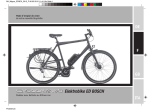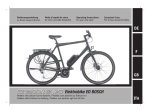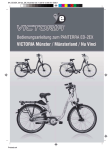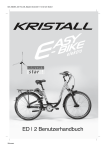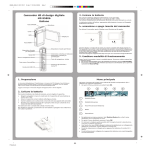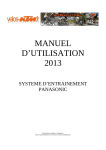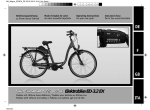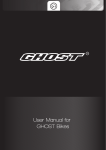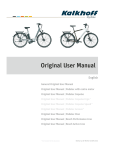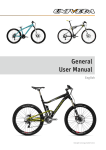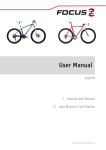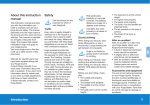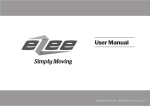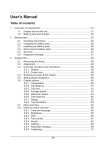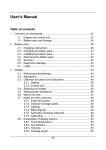Download Operating Instructions - Migros
Transcript
BA_Migros_GB_s1bis32 11.02.2009 12:49 Uhr Seite 1 Operating Instructions Istruzioni d'uso for your new cycle Per la Sua nuova bicicletta GB ITA Pedelec with Lithium-ion battery / Pedelec con batteria agli ioni di litio Probedruck BA_Migros_GB_s1bis32 11.02.2009 12:49 Uhr Seite 2 Operating instructions Operating instructions for CROSSWAVE Electro Bicycle ED-2 EX Pedelec with Lithium-ion battery Istruzioni d'uso CROSSWAVE Elektro-Bike ED-2 EX Pedelec con batteria agli ioni di litio 2 Probedruck BA_Migros_GB_s1bis32 11.02.2009 12:49 Uhr Seite 3 Content Welcome QUICKSTART Your CROSSWAVE Pedelec and its components Before the first start-up Regular inspections - Inspection schedule Loading the Pedelec / Braking response Proper use of the Pedelec Traffic safety tips Guarantee Wear parts 4 6 7 8 9 10 10 10 11 11 12 Start-up - Start up of drive battery - Charging the drive battery - Long-term trickle charging 13 13 15 16 Adjustments before a ride - Handle bar and handle bar stem - Brake - Pedals - Lighting system - Handle bar bearing - Spokes - Quick release - Tyres - Rims - Torque specifications 17 18 19 19 20 20 20 21 21 22 22 Operating the CROSSWAVE Pedelec drive - Recommended method 23 23 Mileage and its factors 24 General operation - Gear - Derailleur - Auxiliary gear with coaster brake hub - Brakes - Coaster brake hub - Hand brake - V-Brake braking - Hydraulic brakes - Roller brakes - Disk brakes 25 25 25 25 25 26 26 26 27 27 27 Load transportation - Trailer - Front wheel luggage carrier - Rear wheel luggage carrier 27 27 28 28 Servicing instructions - Maintenance of the Pedelec drive - General maintenance instructions - Maintenance in winter 28 28 29 29 Structure of the front wheel Battery return / recycling Technical data Faults / cause / remedy 30 31 32 32 3 Probedruck English Pedelec with Lithium-ion battery BA_Migros_GB_s1bis32 11.02.2009 12:49 Uhr Seite 4 Operating instructions Welcome PanTerra™ – Intelligent Electric! Dear Costumer, Thank you for choosing the CROSSWAVE Pedelec – a model with PanTerra™ drive technology! PanTerra offers the technology for an easy, alternative mobility. You will enjoy this modern and eco-friendly mode of travel! This CROSSWAVE electric bicycle is a so-called Pedelec1, i.e., the additional electrical drive assists you up to a speed of 25 km/h while you are pedalling. The technical design of CROSSWAVE Pedelec complies with the European standard EN15194 for electric motor-assisted wheels and the European bicycle standard EN 14764. For driving this Pedelec on public roads in Switzerland, you must be at least 16 years old or have a driving license of the M category (motor cycles2). A Velovignette3 will take care of your liability obligation and insurance. 1 The newly created term Pedelec consists of the words pedal, electric and cycle, and denotes a special type of electric cycle that is different from the so-called e-bike, because law stipulates that its additional drive must work simultaneously with the paddle drive. 2 Traffic Registration Act (VZV), Version on December 5, 2008 3 Traffic Insurance Act (VVV), Version on January 1, 2009 4 Probedruck For your own safety, we recommend that you wear a bicycle helmet while riding the bicycle! This quality product will be a source of joy wherever you go, whether for shopping, to office, for leisure, for picnics or as companion during vacations! We have taken a lot of care in designing and selecting the components so that you have the right vehicle for joining the enthusiastic group of “electrified” bikers! If you follow the numerous suggestions compiled in this manual, you can maintain your Pedelec in an optimal condition and ensure your own safety. As you have purchased this Pedelec from a dealer, it is guaranteed that you have received a fully assembled cycle. In case of any problems or questions associated with repairs, assembly or accessories, you can always count on professional help. This user manual is valid for different models of CROSSWAVE Pedelec. Frame and gear shift can vary. Hence, consider only those sections that are relevant to your cycle. The technical BA_Migros_GB_s1bis32 11.02.2009 12:49 Uhr Seite 5 Pedelec with Lithium-ion battery CAUTION! In the Operating Instructions, you find this sign wherever your safety is concerned. Please inform other users of your cycle about the safety instructions as well! English design of CROSSWAVE Pedelec complies with the upcoming European standard EN15194 for electric motor assisted cycles and with the statutory safety specifications, especially the European bicycle standard DIN-EN 14764. Get ready to be electrified! Your CROSSWAVE Team 5 Probedruck BA_Migros_GB_s1bis32 11.02.2009 12:49 Uhr Seite 6 Operating instructions Quick start 4) Even though you might be eager to use your newly purchased CROSSWAVE Pedelec immediately, we request you to observe the following steps without fail before taking your first ride. PanTerra™ will not accept any guarantee obligations otherwise! You can switch over to power saving mode by actuating the ECO key at the right. 5) Start pedalling. The motor is activated after a half-rotation of the pedals. 1) 6) If you are riding the cycle for the first time, we request you to try out the two drive modes well away from busy roads. 7) There are two drive modes – Normal and Eco. The motor output is limited in the Eco mode. This increases the mileage. 8) At the end of the ride, switch the system off by pressing “O”. 9) The CROSSWAVE Pedelec will take you home even on an empty battery like an ordinary cycle. The battery electronics prevents an excessive discharge of the battery. Remove all the protective foils from the battery. Please check the current charging status of your battery by pressing the key on the LED display (refer to Page 14). The CROSSWAVE Pedelec is powered by a Lithium-ion battery. If less than 2 LEDs light up or no LED lights up, it could be possible that the battery is damaged. In this case, please get in touch with your dealer! Do not try to charge the battery! Do not ride! Now charge the battery fully first! Please use the original PanTerra™ Lithium-ion charging device only. Then insert the battery in the luggage carrier holder and secure the lock (refer to Page 17). 2) Adjust the handle bar and seat; check to ensure that the drive and brakes function and that all screws, especially the wheel nuts are properly fixed (refer to Page 17). 3) Switch the system on at the left of the handle bar: Press the switch to “I” on the control unit. The CROSSWAVE Pedelec is now ready for a ride. The electronic circuit however is deactivated after about 8 minutes of inactivity in order to save energy! If this happens, switch off and then on again. 6 Probedruck 10) Recharge the fully empty Lithium-ion battery after completing the ride. If the Lithium-ion battery is only partially empty, continue to use it for subsequent rides till the battery is completely empty. 11) If you do not use the battery for more than 6 month, recharge it fully. Enjoy your drive on the CROSSWAVE Pedelec! BA_Migros_GB_s1bis32 11.02.2009 12:49 Uhr Seite 7 Pedelec with Lithium-ion battery Your CROSSWAVE Pedelec and its components Drive battery Status display of the drive battery Lock of the drive battery Motor control (electronic) Charging input bushing Crank with rotary sensor Front wheel hub motor Motor plug cover Handle bar operating elements I A English (A) (B) (C) (D) (E) (F) (G) (H) (I) B C D E F Figure 1 H G 7 Probedruck BA_Migros_GB_s1bis32 11.02.2009 12:49 Uhr Seite 8 Operating instructions Before the first start-up Specifications Brakes: A cycle must have at least two brakes that function independently of each other. Bell: A clear sounding bell is mandatory. Lights: Both bulbs must function simultaneously. The centre of the light beam of the front bulb should fall on the road at a maximum of 10 m ahead of the cycle. The rear light must be mounted at a height of minimum 25 cm above the road surface. Reflectors: A white reflector with a large surface area at the front that can be combined with the headlight. In the rear, at least one red reflector should be installed. Optionally, the rear light can be combined with a spot light. Two yellow pedal reflectors per pedal – one towards the front and one to the rear! A parking light or a battery light can be installed additionally. Special rules for sports cycles The following special rules are applicable for racing and mountain bikes: Headlights and taillights can be battery-operated. They need not be mounted permanently on the cycle, but must be used when the light conditions so demand. Nevertheless, sports bicycles must have reflectors. The provisions are not applicable to official tournaments, provided these take place on cordoned off roads. 8 Probedruck Warning Note: Carry out repairs, servicing or adjustments on your bicycle only if you have the requisite knowledge and tools! For your safety, please assign all repair jobs on your bicycle to a specialized workshop or to the Service Department in case of doubt. Components that are bent or damaged due to accidents or improper handling must be replaced immediately to avoid the risk of breakage – e.g., frame, fork, handle bar, handle bar stem, seat support, pedals or crank arms. Info: Ride very carefully in wet conditions. The braking distance increases if the road is slippery. Under wet conditions, the braking distance is two or three times as long. Adjust your manner of driving to the changed conditions. Ride slower and apply the brakes early. Switch the lights on under unfavourable conditions of visibility such as fog, rain, twilight and darkness. If you leave the public roads, drive only on lanes and never on open ground. Adjust your speed according to your riding abilities. Wear tight fitting trousers or use trouser clamps. Wear a helmet for your own safety. Bright, conspicuous clothing is better seen under bad visibility conditions. Do not ride with your hands off the handle bar – risk of accident and fall. BA_Migros_GB_s1bis32 11.02.2009 12:49 Uhr Seite 9 Pedelec with Lithium-ion battery Info: – Proper mounting of the wheels and quick release levers. – The minimum insertion depth of handle bar stem and seat support and their mounting. – Effectiveness and adjustment of the brakes. – Adjustment and bolting of the spring components. – Function of the gear and the lights. – Safe seat of all screws, nuts and the pedals. – The air pressure and the profile depth of the tyres. Regular inspections Check periodically, e.g., after 300–500 km or every 3–6 months, depending on the intensity of use of the cycle to ensure that all screws, nuts and the quick release are fixed properly. Check or service for the first time after approximately 100 km. Checks or servicing is thereafter necessary at regular intervals. The indicated amount of kilometres gives only a rough orientation. You have to take into account the use pattern and the number of kilometres driven in rain. In addition to the jobs that you undertake during the regular inspection, please – – – – English Before the first start-up: Your cycle was tested several times during manufacture and subjected to a final control. Since during transportation of the cycle the settings can change, please check the following without fail before each ride: Clean cycle and oil moveable components. Treat paint rub-offs and rusted areas. Apply protective coating on metal parts. Replace non-functional or damaged parts. IMPORTANT NOTE: Caution! To be able to undertake all the jobs on your cycle on your own, you will need some experience, suitable tools and skills. While tightening the screws, please pay attention to the correct tightening torques. These are given on Page 22 of this Operating Instructions or in the instructions of the component manufacturers. Difficult and safety-related jobs are better to be done by an expert. 9 Probedruck BA_Migros_GB_s1bis32 11.02.2009 12:49 Uhr Seite 10 Operating instructions When? Servicing / check Action After approximately 100 km and subsequently at least 1x per annum Check the tightening torque of screws, cranks, pedals, handle bar, seat support and seat. Adjustment of gear, control set, spring elements and brakes. Check the wheels and tyres Customer Service, Service Department or specialized workshop After every ride Check the rims, spokes, tyres, bell, brakes, quick release, lights and the function of the gear and springs Check the rims for concentricity and wear marks. Check tyres for foreign bodies Regularly after 300–500 km Check the cranks, sprocket wheel and pinion. Check chain wear and tear, stability of all screws, wear indication on the rim Clean and apply chain grease After 1000 km Back pedal brake, VR-HR hubs Dismantle, clean and apply grease. Check brake jacket, replace if necessary After 3000 km Control set, pedals, hubs, brake and control wires*) Let Service check, dismantle, clean, lubricate and replace if necessary Chain, brake, wiring Clean, lubricate After rain * Do not oil Teflon coated cable jackets! 10 Probedruck Loading the Pedelec – The permissible total load (rider and luggage) on the CROSSWAVE Pedelec is 120kg. – The permissible load of the luggage carrier is mentioned on the luggage carrier. – If your cycle is equipped with a front basket, the additional load allowed here is 5kg. Braking response – Use the front wheel brake carefully on wet, sandy and slippery roads, wet asphalt and ice, to keep the front wheel from skidding and to retain the Pedelec under control! – The brakes must be used with care. Blocked wheels have a reduced braking effect and can lead to loss of balance and fall! – As a matter of principle, do not apply the brakes in curves but before them; braking increases the risk of skidding! – The braking lever mounted on the handle bar must always be tight. Check regularly to ensure that they are not loose, and tighten if necessary. – Work on the brake system should be entrusted exclusively to the dealer! Proper use of the Pedelec: Your Pedelec has been designed and equipped like a bicycle for the use on public roads and paved lanes. Please bear this in mind when using the Pedelec under off-road conditions and in case of overloading and improper rectification of faults. BA_Migros_GB_s1bis32 11.02.2009 12:49 Uhr Seite 11 Pedelec with Lithium-ion battery Caution! Learn the traffic rules before venturing out onto busy roads. Learn to anticipate the errors of other drivers! > Please ride only on the designated lanes and roads, not over meadows and fields or across forests. > Never ride the bicycle through water. > Pay attention to pedestrians and hikers; your hands should be ready to apply the brakes at blind curves/corners and while riding downhill, pay attention to your speed and do not leave any skid marks. Caution! Riding in the open fields requires a lot of skill, good fitness and high concentration. Start with easy tours and increase your difficulty level gradually. Guarantee 1) Guarantee: Your decision to buy a cycle from our company entitles you to own a top quality product. Migros gives you a guarantee of 2 years. 2) The guarantee does not cover the following: – All damages attributable to improper use and application of force (refer to information about proper use of the Pedelec). – Components of the cycle that are subject to use-related wear and tear, unless there are production faults or material defects. (Refer to list of possible wear parts on Page 12). – Damages to the cycle attributable to improper or faulty maintenance and to unprofessionally executed repairs, alterations or replacement of parts. Detailed servicing or maintenance instructions are given in this Operating Instructions. – Accident damages or other such unusual external effects, unless these are attributable to improper information or product faults. – Repairs made with used parts or damages ensuing there of. – Damages on account of use of the product in competitions. (Refer to information about proper use of the Pedelec according to manufacturer instructions). – For subsequent attachments that were not a part of the delivery scope of the product on the hand over date, or damages that occur on account of unprofessional assembly of these attachments. Info: For valid warranty claims, the buyer must present the original purchase receipt to the vendor. 11 Probedruck English Caution! Traffic safety tips: > Always observe the traffic rules. > Drive carefully. Do not endanger or provoke other vehicle drivers. > Switch the lights on early if it is getting dark. > Cycling is prohibited on the highways. Danger to life! > Keep sufficient distance from automobiles in front; these normally have a shorter braking distance. > Wear bright clothes so that you are detected early. > Always wear a helmet. > Ensure that your cycle is always in roadworthy condition. > Children below 6 years should always use the footpath. Children must always climb down from the cycle before crossing a traffic lane. For reasons of safety, the rider must avoid listening to music with headphones in the midst of vehicular traffic. BA_Migros_GB_s1bis32 11.02.2009 12:49 Uhr Seite 12 Operating instructions Parts subjected to regular wear and tear Please note: List of parts subjected to regular wear and tear 1) 2) 3) 4) 5) 6) 7) 8) 9) 10) Tyres Rim in connection with rim brake Brake jackets Chain and drive belt Sprockets, pinions, inner bearings and transmission rollers Bulbs and lighting system Handle bar tapes / handle covers Hydraulic oils and lubricants Gear and brake jackets Paint 1) Tyres The cycle tyres are subject to use related wear and tear. The extend depends on the use of the cycle and can be influenced to a great deal by the rider. Sharp braking that leads to the blocking of the tyre reduces the life of the tyre significantly. Moreover, the air pressure should be checked regularly and if necessary, increased to the value specified by the tyre manufacturer. Excessive exposure to the sun, petrol, oils etc. can damage the tyres. 2) Rims in connection with rim brakes Not only the brake pad but also the rim is subjected to use related wear on account of the interaction between the rim brake and the rim. Hence, the rim should be checked at regular intervals for wear and tear. The occurrence of fine cracks or 12 Probedruck deformation of the rim horns when increasing the air pressure indicates heavy wear and tear. Rims with wear indicators enable the rider to detect the wear condition of the rim easily. 3) Brake pads The brake pads for rim brakes, drum brakes and disk brakes are subject to use related wear and tear. This depends on the use of the cycle. Riding the cycle in rough or hilly terrain or using it for sports activities can necessitate the replacement of the brake pads at shorter intervals. Check the wear condition of the covers and let your service partner replace them. 4) Chains and drive belts The cycle chain is subject of use related wear and tear. The extent of the wear depends on the servicing and maintenance and the type of use of the cycle (mileage, riding in rain, dirt and pollution, salt etc.). Regular cleaning and oiling can increase the life, but replacement is necessary on reaching the wear limit (approximately 2000–3000 km). 5) Sprockets, pinions, inner bearings and transmission rollers In cycles with derailleur, the pinion, sprockets, inner bearings and transmission rollers are subject to use related wear and tear. Regular cleaning and lubrication can increase their life, but replacement is necessary on reaching the wear limit. The extent of wear depends on maintenance, servicing, the type of use of the cycle (mileage, riding in the rain, dirt and pollution, salt etc.). BA_Migros_GB_s1bis32 11.02.2009 12:49 Uhr Seite 13 Pedelec with Lithium-ion battery 7) Handle bar tapes and handle covers Handle bar tapes and handle covers are subject to use related wear. Replacement may be necessary regularly for this reason. Ensure that the handles are connected tightly to the handle bar. 8) Hydraulic oils and lubricants Hydraulic oils lose their efficacy in the course of time. All lubrication points should be cleaned regularly and re-lubricated. Non replaced lubricants increase the wear in the attached parts and bearings. 9) Cable and brake housing All Bowden housings must be serviced regularly and replaced if necessary. This can be the case especially if the cycle is placed in the open frequently and is exposed to weather influences. 10) Paintwork Paintwork requires regular maintenance. Check all painted surfaces regularly for damages and rectify them immediately. This will also preserve the good look of your cycle. Start-up of the CROSSWAVE Pedelec The following chapters of the user manual of the CROSSWAVE Pedelec presume that all basic ergonomic settings and necessary safety checks of your bike have already been done: – Handle bar and seat have been brought to the desired position and tightened appropriately. – The wheels have sufficient tyre pressure and their axle nuts have been tightened too. – The function of the brakes and pedal drive has been checked. – The lighting system is functioning. For more information refer to the Chapter “Adjustments before ride”. Start-up of the drive battery: Now take the drive battery out of the holder in the luggage carrier of the CROSSWAVE Pedelec. Remove any protective foils – especially the ones on the electrical contacts located at the lower end. Now check the charging state of the battery by pressing the key on the LED-charging status display. If less than two LEDs or no LED lights up, the battery may be damaged. In this case please contact your dealer. 13 Probedruck English 6) Bulbs of the lighting system Light bulbs and other lamps are subject to use related wear. Hence, replacement may be necessary. The user must always carry spare light bulbs to enable timely replacement. BA_Migros_GB_s1bis32 11.02.2009 12:49 Uhr Seite 14 Operating instructions Check the charging status of the battery. To do this, press the knob at the LED display on the top side of the battery. Refer to Figure 2 Figure 2 The compartment containing the battery fuse is located on the side (cover with the imprint “Fuse”). If you do not want to use your battery anymore, please pull this fuse out. The protective electronic circuit of the battery will otherwise continue to draw a small amount of power, quite unnecessarily. Insert the drive battery in the CROSSWAVE Pedelec as illustrated in Figures 3 and 4 into the tray. Ensure that the contact pins of the motor electronics which is permanently fixed in the tray, slide smoothly into the contact strip of the drive battery. If all the 5 LEDs do not light up, PanTerra™ recommends that you first charge the battery fully. To do this, connect the drive battery to the charging device included in the scope of delivery. Refer to the Chapter “Charging the drive battery” on Page 15. Lithium-ion batteries get self-discharged much slower than Nickel batteries and can therefore be stored for approximately 6 months without recharging. However, if the battery is not recharged after this period, the chemical structure can be damaged, which affects the performance of the battery considerably and can make it unusable. 14 Probedruck Figure 3 Figure 4 The drive battery should be kept flat in the tray as shown in Figure 4. Let the cylinder snap into place in the battery housing. The locking ensures that the battery is held tightly to avoid damages caused by jerks and vibrations. It also guarantees optimum electrical contact of the battery with the electronic circuit in the Pedelec. BA_Migros_GB_s1bis32 11.02.2009 12:49 Uhr Seite 15 Pedelec with Lithium-ion battery The key can be taken out in the opened and locked position! PanTerra™ recommends that you remove the keys at all times! This will ensure that the lock cannot be opened inadvertently (and the battery falls out) and also that the key does not get lost. The charging device is intended for inside use only and it should not be exposed to dust or water. Read the attached Operating Instructions of the charging device before using it for the first time. Charging the drive battery: The CROSSWAVE Pedelec runs on a 25V 11Ah Lithium-ion battery. PanTerra™ uses high class branded cells that are combined into a 25V cell pack. Besides, the battery contains a safety electronic circuit that prevents excessive discharging and overcharging. Avoid storing a fully discharged battery for weeks. Always use only the high class Lithium-ion charging device included in the delivery scope or the corresponding original PanTerra™ spare part to charge your drive battery. The original charging device works with CC-CV technology. English The CROSSWAVE Pedelec is now ready for a ride! Figure 6 Figure 5 The battery safety electronic circuit guarantees that the battery is not damaged on account of wrong charging currents or overcharging at any time. Take the charging device out of the box, unwind the cable bundle and plug it into the two-pin charging socket located on the bottom side of the drive battery (Figure 5). It is protected against spray water by a rubber cap. The battery can also be charged on the cycle. 4 CC-CV = Constant Current – Constant Voltage: Controlled current strength is first used to charge quickly and the battery voltage increases. On approaching the maximum capacity, the current strength is reduced and the remaining capacity is filled only with exact maximum specified voltage. Connect the charging device to the mains socket with the help of the power cable included in the delivery scope. The charging operation starts. The LED switches to green after a few minutes if the battery pack is already in an almost fully charged condition, i.e., charging is completed. 15 Probedruck BA_Migros_GB_s1bis32 11.02.2009 12:49 Uhr Seite 16 Operating instructions Full charging can take up to 6.5 hours. (CC-CV charging specifies that although approximately 95% of the charging is completed in (11Ah/2A=) 5.5h, more than one hour is still required for filling the remaining capacity in the slow CV mode.) Charging device LED Mode Steady green light Charging completed/no battery Steady red light Normal charging, CCCV Flashing green Charging device is defective Flashing red Battery is defective Danger of short circuit! Ensure that no metallic objects come close to the battery contacts and the charging plug. Long-term trickle charging: Lithium-ion batteries do not receive any long-time trickle charging. Their self discharge is too low and the associated charging devices therefore are not designed for it. It is therefore not recommended to connect the battery to the charging device continuously over a prolonged period of absence especially in winter. The safety electronic circuit in the battery will prevent any damage, but the charging device would be working all the time. Electrical devices should not be connected to the mains over long periods without supervision. Hence, you should pull out the power plug from the mains socket during vacations or during long periods of absence. The battery should not be charged at very high and very low temperatures (below -10 °C and above +40 °C). We recommend that the cycle should not be exposed to bright sunlight during charging. Tip: If you do not use the Pedelec for long intervals, please recharge the Lithium-ion battery once every six months. Pull out the fuse from the battery during storage to rule out consumption of electricity (very little) by the protective electronic circuit itself. Of course, you must reinsert this fuse before charging again. 16 Probedruck BA_Migros_GB_s1bis32 11.02.2009 12:49 Uhr Seite 17 Pedelec with Lithium-ion battery Check the following before each ride – All screws, wheel nuts or quick release are tight – The brakes function – The air pressure of the tyres is sufficient – The lighting system is intact – The bell is OK. Seat and handle bar: You bicycle is assembled by the dealer and is in a road-worthy condition. The handle bar and seat position is adjusted to your height. While adjusting the seat and handle bar height, pay attention to the minimum insertion depth marked on the handle stem shaft and seat support. Never pull out the handle bar or seat above the marking! Seat: The seat can be adjusted in three directions: height, inclination and distance from handle bar (Figures 7, 8): Figure 7 Figure 8 Height: – Loosen the seat clamping bolts (Figure 7 Pos. 1) or quick release (Figure 8 Pos. 1) – Move the seat support in or out – Tighten the clamp after making the adjustment. You have adjusted the seat height according to your body size, so that, while sitting on the seat, the tips of your toes touch the ground on both sides. Caution! The seat support must remain clamped at least up to the mark. Otherwise it might break, leading to a fall! Leather seats can discolour clothes when used initially under wet conditions. Frequent re-adjustments of the seat can leave permanent scratches on the surface of the seat support due to the mechanical action. These damages fall under normal wear and tear, and do not constitute a case of materials defect liability. Inclination of the seat and distance from handle bar (Figures 7, 8): – Loosen the nut of seat piston or inner hexagon bolt (2) – Move seat forward or backward – Incline the seat – Tighten the nut or inner hexagon bolt 17 Probedruck English Adjustments before a ride BA_Migros_GB_s1bis32 11.02.2009 12:49 Uhr Seite 18 Operating instructions Handle bar and handle bar stem Caution! Please pay attention to the marking, which should under no circumstance project out of the control tube. Danger of breaking – and therefore, risk of falling! Frequent re-adjustments of the seat can leave permanent scratches on the surface of the seat support due to mechanical action. These damages falls under normal wear and tear, and does not constitute a case of materials defect liability. Caution! After a fall on the handle bar, you must replace the handle bar and stem. Invisible micro cracks can lead to breakage and therefore, pose a risk of falling! The handle bar can be adjusted as follows (Figures 9, 10): Figure 9 Figure 10 Adjusting the inclination of the handle bar: – Loosing the joint (Figure 9, 10, pos. 2) – Rotate to the correct position – Tighten the joint Angular adjustment of handle bar stem: This stem offers more flexibility in adjusting the handle bar position: Figure 11 Adjusting height: – Loosen the nut or inner hexagon bolt of the expander bolt (Figure 9, 10, pos.1) – Loosen the bolt with a gentle hammer blow and adjust the correct handle bar height. – Tighten the expander bolt finally. 18 Probedruck Adjustment: – Loosen the screw joint. – Rotate the handle bar to the desired position. – Tighten the screw joint. BA_Migros_GB_s1bis32 11.02.2009 12:49 Uhr Seite 19 Pedelec with Lithium-ion battery “Front-stem” Figure 12 Pedals The pedals must be fixed tightly at all times. During assembly and dismantling, please keep in mind that the pedals have two types of threads. The threads on the pedals and the treadle are exposed to strong forces. They hold only if the pedals are screwed tightly. Brake The brake system must be checked before each ride. Only the dealer should be entrusted with the job of adjusting the brakes. The left pedal is marked with L at the axle end and has lefthand threads. Figure 13 Readjustment of the brakes is required when you observe an increasing idle travel of the hand brake lever. The same comes closer and closer to the handle bar grip due to the wear and tear of the brake rubber (shoe). Regular readjustment is necessary. The brake rubbers are parts subjected to wear and tear and they do not constitute a materials defect liability. Rear wheel back pedal brake This brake cannot be adjusted.Please note that the brake becomes ineffective the moment the chain is damaged or comes off. left-hand thread right-hand thread The right pedal must therefore be screwed in the clockwise direction, while the left pedal must be screwed in the opposite direction. Foot pedals The foot pedals are mounted with hexagon bolts on the square attachments of the bottom bracket axle. The stable hub of the foot pedal must be checked regularly. Remove the safety caps and tighten the screws located below them. 19 Probedruck English The right pedal (chain side) is marked with R at the axle end and has right-hand threads. BA_Migros_GB_s1bis32 11.02.2009 12:49 Uhr Seite 20 Operating instructions Lighting system The CROSSWAVE Pedelec is equipped with a lighting system that draws power from the drive battery. It is switched on and off via a switch on the front headlight (Figure 14). An electronic circuit in the headlight converts the 25V of the drive battery into 6V for the light. Figure14 Handle bar bearing Check: – Apply the brake for the front wheel and move the cycle forward and backward. If there is too much tolerance due to wear and tear, the bearing must be adjusted without delay. The adjustment should be done by a specialized workshop. Figure 15 As the power requirement of the bicycle lighting is very low, a light left on would last about 2-3 days. Moreover, the protective electronic circuit prevents a depth discharge of the battery if the light remains switched on inadvertently. Caution! Nevertheless, always switch the light off while parking the Pedelec else you might suddenly find the battery empty. 20 Probedruck Spokes The spokes expand and become loose in course of time. They must be centred regularly according to the degree of use. The centring of the wheel and tightening of the spokes should be entrusted to a specialized workshop. A uniform and proper tightening of the spokes is necessary for a uniform rotation of the wheels. Loose spokes, non-uniform spanning or overload may lead to broken spokes. BA_Migros_GB_s1bis32 11.02.2009 12:49 Uhr Seite 21 Pedelec with Lithium-ion battery Before going on a ride, check that the quick release is closed and fixed. If the front wheel clamp gets loose when you apply the brakes, stop right away and tighten the quick release. Tyres and rims The maximum permissible tyre pressure is specified on the outer side of the tyre. Do not ride the cycle with too little air (wheel skims) or too much air (tube explodes). Wrong air pressure or flat tyres lead to increased wear and tear even if the bicycle is not used. Our recommendation: Tyre size Caution! A loose wheel, especially a loose front wheel poses maximum risk of falling! The quick release lever has two positions, CLOSE and OPEN. First adjust the tightness with the nut M. Then press the lever with a little force to the position CLOSE. Figure 16 47-559 (26“x1,75x2) 50-559 (26“x1,90) 52-559 (26“x2,25x2) 57-559 (26“x2,125) 37-622 (28“x1 3/8x1 5/8) 40-622 (28“x1 3/8) 47-622 (28“x1,75x2) 50-622 (28“x1,90) There are 3 valve systems for cycle tubes: Air pressure (bar) Front Rear 3,0 2,5 2,5 2,0 2,5 2,0 2,5 2,0 4,0 3,5 3,5 3,0 3,0 2,5 3,0 2,5 Figure 17 OPEN CLOSE Please note that in case of Sclaverand valves, you must first remove the dust cap and loosen the knurled screw to pump or vent air. Always make sure that the tyres have sufficient profile and an undamaged body. 21 Probedruck English Quick release Quick release is found at the front and rear wheels as well as at the seat tube clamp, depending on the model. BA_Migros_GB_s1bis32 11.02.2009 12:49 Uhr Seite 22 Operating instructions Rims Torque specifications CAUTION against rim wear! Check the condition of your rims regularly. Please contact your dealer in time. RISK OF FALL AND ACCIDENT! Rim wear indicator: Many aluminium rims are equipped with a wear indicator. Request your dealer to provide detailed information. Chain tensioning Ensure that the chain is tensioned correctly; it is the most important part of the drive module. A regular check is necessary since the chain stretches in course of time. If necessary get the chain re-tensioned by the dealer. As shown in Figure 18, it should be possible to slightly move the chain up and down by approximately 1.5 cm at the centre of the two sprockets. Figure 18 22 Probedruck Axle nuts of front wheel Axle nuts of rear wheel Foot pedal mounting Brake pad mounting Dynamo mounting Other screws: M4 M5 M6 M8 M10 20 Nm 25 Nm 30 Nm 5 Nm 10 Nm 2,1 Nm 4,2 Nm 7,3 Nm 17 Nm 34 Nm BA_Migros_GB_s1bis32 11.02.2009 12:49 Uhr Seite 23 Pedelec with Lithium-ion battery Please read the Chapter "General Operation” for operating the cycle. On the handle bar towards the left there is a control panel for controlling the auxiliary electrical drive (Figure 19). Here, the CROSSWAVE™ Pedelec is switched on and off. The desired drive mode is also activated here. A four-phase LED at the left displays the battery charge status, i.e., the remaining capacity. Press the centre switch to activate the system. Up to four LEDs light up to indicate the drive battery status, one LED indicates Power (On) and, if applicable, another one the ECO mode. The left switch on the left can be used to activate and deactivate the economical ECO mode. It limits the driving power and helps significantly to spare battery capacity. The auxiliary drive of the CROSSWAVE Pedelec starts automatically after half a pedal rotation. Thus the CROSSWAVE Pedelec complies completely with the upcoming European standard for this vehicle type. Recommended manner of driving: After activating the system, select the drive mode and set the CROSSWAVE Pedelec in motion by pedalling. At gradual ascents, the Pedelec should be pushed gently on foot so that the motor does not have to gain force from zero rotation. Otherwise, it would draw a lot of power and would not develop any appreciable propulsion between 0 to 3 km/h. To increase the mileage, you should also apply force on the pedals in all driving situations, because if you drive with motor power only, the performance of the system remains conspicuously below its possibilities. The activated ECO mode limits the maximum driving power and spares battery capacity. The reduced assistance can be felt only while ascending hills and while accelerating. Figure 19 (left) Figure 20 (right) 23 Probedruck English Operation of the CROSSWAVE Pedelec drive BA_Migros_GB_s1bis32 11.02.2009 12:49 Uhr Seite 24 Operating instructions Mileage and its factors The mileage that can be achieved with a fully charged battery is additionally determined by factors such as slopes, head wind, road surface quality, tyre pressure, use of gears as well as pedal support and the weight of the rider. At average utilization of the pedalling support and fully charged battery, the typical operating distance lies between 35 and 50 km. Normal mode Eco mode up to 35-50 km up to 60 km It is nearly impossible to specify the exact operation distance because different factors influence the support output. First, the battery must be optimally charged. This is guaranteed by using an original battery charger. Other factors are sufficient charging time, the age of the battery as well as its maintenance. If all conditions are optimal, i.e., the operating temperature is between 5 and 35°C, and the battery is fully charged, the amount of energy available at the start of the ride should be 25V x 11Ah = 275Wh. As the battery ages, the maximum quantity of stored energy can come down by 1/3, and the mileage gets reduced accordingly. 24 Probedruck Lithium-ion batteries can normally experience up to 500 full charging cycles, but the capacity gets reduced in the course of time to 85-65% because a mild chemical aging affects the inner cell structure after about 12-18 months. With good maintenance, a product life of about 3 years is possible. The capacity will come down very gradually but uniformly. BA_Migros_GB_s1bis32 11.02.2009 12:49 Uhr Seite 25 Pedelec with Lithium-ion battery Gear changing If you are not yet familiar with a gear change, practice handling your new Pedelec, braking and negotiating curves but do it away from public roads. Derailleur First switch the chain to the centre pinion at the rear. Switch between the front chain rings. Then try the same in the reverse direction. This way you will learn the functioning of the gear. Do not ever change gear when the cycle is stationary or during reverse pedalling. Select your gear transmission ratio in front according to the terrain and exercise additional control with the rear sprocket. The chain should not run crosswise, i.e., with very steep inclination, because otherwise chain and gear wheel will wear out fast. Use the derailleur as illustrated in Figure 21. Auxiliary gear with coaster brake hub While using a gear hub, stop pedalling for a moment so that the gear can switch. Due to the gear cable expansion, the gear hub requires regular readjustment by the dealer. Gear hubs with 3-, 4-, 5-, 7-, 8- and 9 gears offered by different manufacturers are available at present. Please contact your dealer to adjust your individual gear model or follow the corresponding operating instructions of the gear manufacturer. Brakes Your Pedelec is equipped with two independent brakes. The right brake lever works on the front wheel brake, and the left one on the rear wheel brake. You can change this order by changing the brake wires on the brake lever. Get this done by your dealer. Figure 21 Gear adjustment: The gear must be adjusted regularly, depending on the type of gear usage. Let your dealer do all the gear settings. 25 Probedruck English General operation BA_Migros_GB_s1bis32 11.02.2009 12:49 Uhr Seite 26 Operating instructions Coaster brake hub The back pedal brake is a rear wheel brake that is activated when you pedal backwards. You must practice a little to get the hang of when the brake is triggered. Use the second brake, i.e., the front wheel brake alternately during long and steep rides, so that the rear wheel brake can cool down! Very intense heating of the back pedal hub leads to loss of lubricant! Re-lubrication is necessary! The brake body of a back pedal brake is also subject to wear and tear depending on the usage and must be replaced accordingly. Let the dealer execute such jobs. Hand brakes Check the smooth functioning of the brakes before each trip. Contact the dealer if you detect slackening of the braking effect! The brake shoe or shoes are labelled. Always use spare parts of the same label. V-brake This brake is activated by pulling the brake lever at the handle bar of your cycle. Two brake shoes act on the rim edges. 26 Probedruck Due to its improved design, the V-brake achieves excellent braking values under dry and wet conditions, but holds certain risks, especially for inexperienced cycle riders. You can lose control over your cycle if you apply the brake in the wrong way. Practice applying this brake, particularly if you are a beginner. Ride slowly at first and use the brake lever carefully to familiarize yourself with the response of the brakes. Caution! Risk of fall and injury when applying the brake suddenly in emergency situations! Please contact your dealer to learn how to adjust the braking power and study the relevant instruction leaflet of the manufacturer. BA_Migros_GB_s1bis32 11.02.2009 12:49 Uhr Seite 27 Pedelec with Lithium-ion battery Instead of Bowden control cables, this brake has brake tubes that are filled with hydraulic oil. Consult your dealer and read the detailed technical instructions of the manufacturer. The hydraulic brake is very sensitive and can be exactly calibrated. You can test the brake response through a trial run. Caution! Risk of fall and injury when applying the brake suddenly in emergency situations! Roller brake This brake too is activated with the help of the brake lever on the handle bar. The braking mechanism acts on the wheel hub and is well protected from bad weather. Please note that a large frictional heat is generated, resulting in heat accumulation, if you apply the brake for a long time (going downhill). Disk brake This brake too is activated with the help of the brake lever on the handle bar. The principle is similar to that of the rim brake, the only difference being that this brake sits on the hub. The brake pads act on a brake disk. Load transportation – When transporting loads, ensure they are fastened well. Always observe the permissible carrying capacity of the luggage carrier! – Do not carry any bags or other objects on your handle bar! This affects the driving safety. Aluminium handle bars are not designed to support loads! Trailer – Observe the maximum permissible speed of 25 km/h if you use a trailer. – Max. permissible trailer load is 40 kg Caution! The driving and braking behaviour of the cycle changes. Risk of fall and injury! Caution! Do not touch the heated hub body. Cooling-off time after prolonged braking when going downhill is approximately 30 minutes. 27 Probedruck English Hydraulic brake This brake is also activated by pulling the brake lever at the handle bar of your cycle. Two brake rubbers act on the rim edges. BA_Migros_GB_s1bis32 11.02.2009 12:49 Uhr Seite 28 Operating instructions – Use only tested trailer couplings and fix them at the prescribed positions. – Use only trailers that correspond to the latest safety technology. – First try out the trailer without load. – Follow the StVZO (Road Traffic Licensing Regulations) requirements for the lighting equipment of the trailer. – No liability for damages on account of trailer usage! Front wheel luggage carrier, basket – Follow the manufacturer specifications on the components for loading. – Avoid overloading! – Do not transport any living animals! Rear wheel luggage carrier – Observe the manufacturer specifications on the components for loading. – Use the standard transportation bags, baskets and clamping devices. – Do not transport any persons or living animals. Maintenance instructions To enjoy the comfort of the numerous functions for a long time to come, the CROSSWAVE Pedelec should be maintained just like a normal cycle. Besides, to guarantee riding safety, regular checks must be performed on the brake, the tyre pressure, the different screw joints, especially handle bar, seat and axle nuts without fail. Maintenance of the Pedelec drive: When maintaining the auxiliary electrical drive system, ensure through appropriate handling the maximum capacity of the drive battery and protection of the other electrical components against prolonged wet conditions. As far as possible, the Lithium-ion battery should be recharged only after complete discharge. Please try to avoid immediate re-charging of a nearly full battery after a short ride. In winter or during longer periods of non-use, the battery should be recharged at the latest after six months. Only this way you can ensure a long product life. If you do not use the battery over longer periods, take the battery out of the Pedelec and pull out the fuse so that no standby current in the electronic circuit is unnecessary consumed. After a ride in rain or if a lot of mud gets deposited on the housing components, the dirt must be wiped away as thoroughly as possible with a wet sponge. Let the CROSSWAVE Pedelec dry afterwards. 28 Probedruck BA_Migros_GB_s1bis32 11.02.2009 12:49 Uhr Seite 29 Pedelec with Lithium-ion battery Hence, avoid transporting the Pedelec on the luggage rack of your car with the battery inserted when it is raining. The strong slip stream forces water all across the frame and into the battery housing. If such transportation is required, do not forget to take the battery out of the CROSSWAVE Pedelec and upon arrival, dry the wet bicycle sufficiently before re-inserting the battery. General maintenance instructions: – Before using the Pedelec, it is recommended that you protect the chrome parts and the frame with any commercial cycle care product. – Clean the cycle regularly from dust and dirt with a sponge or soft cloth. Use a normal cycle cleaning product and a protective agent . – Never use high-pressure cleaners to clean hubs and pedal bearing. This will damage the components. – Ensure that the tyres and brake rubber do not come in contact with oil. Maintenance in winter: The Pedelec should be carefully preserved in case of long-term storage in the winter months. Ensure that the Pedelec is parked in a room with constant temperature. Large temperature fluctuations as well as humidity have a negative effect on all Chromium and light metal components. To store it away for winter, check the Pedelec on the whole for damages to avoid any workshop repairs in spring. Unburden the tyres by hanging up the Pedelec. If you do not intend using the Pedelec for longer periods, pull out the fuse of the battery and store it in a cool and dry room. The recommended storage temperature for the battery is 15°C. Pay attention to all the other assembly, servicing and maintenance instructions mentioned in this manual as well as to the instructions of the gear manufacturer. 29 Probedruck English Never use a pressurized water jet or a steam-cleaning device. The system is protected against water sprays and is therefore rainproof, however, the electrical socket-plug connections are not fully sealed. Thorough wetting of the cable harness can lead to short-circuits that can instantly destroy the digital control of the system. BA_Migros_GB_s1bis32 11.02.2009 12:49 Uhr Seite 30 Operating instructions Dismantling the front wheel If due to a tyre damage you have to dismantle the front wheel, please proceed as follows: Dismantling: Open the cover on the axle nut (Figure 22) on the right side of the fork. It contains the detachable plug-in connection of all motor cables. Loosen the two screws and apply mild pressure to pull the plastic cover out. Figure 22 30 Probedruck Figure 23 Below you will find the two plug-in connectors for driving power (big) and runner position control (small) (Figure 23). Memorize the position of the cables under this cover; otherwise a wrong position of the cables can later prevent the closing of the cover. Refer to Section “Assembly”. The plug-in connector can be disconnected by unlocking the safety hooks. If you press them, the plug-in connector can be detached. Refer to Figure 24. The plug-in connector for driving power (big) could be slightly different in your bicycle. The round connectors are simply pulled apart. Figure 24 Figure 25 BA_Migros_GB_s1bis32 11.02.2009 12:49 Uhr Seite 31 Pedelec with Lithium-ion battery Assembly: Insert the front wheel and place the torque protection washers on the hub axle inside the fork, and put the spacer disks and the base plate of the cover back at the right position. Give a few turns to the axle nuts. Align the front wheel and tighten the axle nuts. Connect the plug-in connector. The position of the two plugin connectors is determined by the cable lengths. In any case, try to restore the previous arrangement. (Figure 24) Battery return / recycling Please do not dispose the battery pack with other household garbage. Appropriate containers have been provided by the battery industry as well as the community collection centres for the proper disposal of batteries. If you want to send a battery pack, please talk to your dealer, because Lithium-ion batteries cannot be shipped without labelling5. English Now loosen the two axle nuts. You can now separate the remaining parts from the fork (Figure 25). The axle nut, the base plate, two 3mm spacer disks and the torque supporting washers remain connected with the plug of the motor cable on the right side. Do not dismantle further. The front wheel can now be taken out and any tyre, hose or spoke damages can now be rectified. Please also observe the instructions printed at the bottom of the battery: Now replace the cover. Check that the cable and the plug-in connector lie neatly under the cover without any substantial pressure. Insert the two cover holder screws and tighten them. 5 Lithium ion batteries are classified as hazardous substances due to their Lithium content, which is chemically very reactive. They are therefore subjected to mandatory accident safety tests in the development phase, which ensure that an external destructive impact does not trigger any uncontrollable processes. The correct labeling on dispatch packages e.g. helps the fire brigade to decide which fire extinguishing system should be used in case of car accident. Certain cell structure technologies and a protective circuit ensure that no electrical overloads occur during normal operation. 31 Probedruck BA_Migros_GB_s1bis32 11.02.2009 12:49 Uhr Seite 32 Operating instructions Technical data of CROSSWAVE Pedelec Drive system Pedelec/EPAC6 (Electrical Power Assist Cycle) Extra cycle drive with 250W motor, up to 25km/h, activated via Pedal rotary sensor. Motor BLDC gear - motor. The full form of BLDC is Brushless-DC i.e., a brushless electronically commuted 3-phase DC motor, works with max. 250W steady nominal power. Control Battery 25V x 11Ah = 275Wh Lithium-ion battery of European manufacture with 5 LED capacity display, weight 2.4 kg, up to 500 charging cycles or 3-4 years life expectancy under optimum use conditions. Charging device CC-CV charging device with 2.5A charging current full charging of 11Ah battery lasts about 6 h. Mileage Depends predominantly on the selected drive mode, personal driving style and other factors – 35-50km in the Normal mode – 60km in the Eco mode Refer to Chapter "Mileage and its factors". 6 EPAC 32 Probedruck BLDC motor controller with digital program control according to Euro standard 2 Drive modes: Normal and Eco. The auxiliary drive is activated automatically on using the pedals and supports up to 25km/h. The auxiliary drive is shut down automatically on applying the brake. The driving power is limited in the ECO mode. = Pedelec Faults / Cause / Remedy 1. Operating unit 1.1 No LED lights up at the left on activating the Pedelec Cause: Remedy: Battery is not inserted properly > Re-insert battery Fault in battery >Contact dealer Cable / contact fault > Contact dealer Electronic circuit is defective > Contact dealer 1.2 The Pedelec switches off during the drive Cause: Battery is empty Electronic circuit is defective Plug-in connection has disengaged Remedy: > Recharge battery fully > Contact dealer > Contact dealer 2. Battery 2.1 No LED lights up on pressing the battery charging status display switch Cause: Remedy: Battery is empty > Charge the battery fully. Fuse in the battery is defective > Replace fuse Cells in the battery pack are defective > Contact dealer 2.2 The capacity of the battery has come down drastically Cause: Remedy: The battery is used-up (old) > Replace the battery The charging device is defective > Contact dealer Charging plug / charging cable is damaged > Contact dealer 3. Motor 3.1 The motor does not run, but the operating elements and the battery function Cause: Remedy: The motor cable is covered > Check plug, it is not inserted properly Other cable / contact fault > Contact dealer Pedal sensor is defective > Contact dealer Electronic circuit is defective > Contact dealer 4. Pedal sensor 4.1 The motor does not work, but the operating elements and the battery function Cause: Remedy: Direction of pedal sensor is incorrect > Contact dealer Pedal sensor is defective > Contact dealer 5. Charging device Refer to Chapter "Charging the drive battery" or Item 2.2 of this list

































